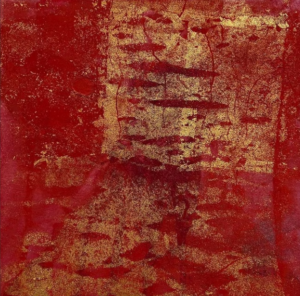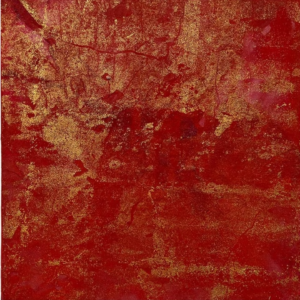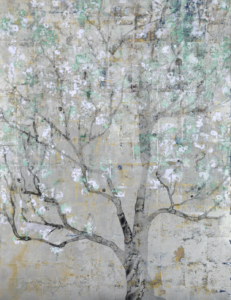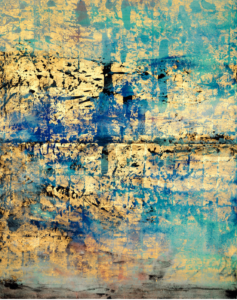Samuel Loncar on Makoto Fujimura
We live everyday on the brink of the abyss. Artists feel this. They smell darkness, inhale light. In what may be the oldest Greek myth of the gods, even Zeus himself, the almighty, journeys to the great goddess, Night, and asks her: What should I do? After their meeting, he recreates the world anew. Night is our most ancient councilor. In night, we dream. In dreams, we see reality in true tokens of its strangeness, its wonder, terror, and grandeur. “In art,” says Makoto Fujumura, “we do not ‘obliterate the darkness;’ art is an attempt to define the boundaries of the darkness.”
As artists work with the darkness so, in Fujimura’s vision, they embrace brokenness. I recently held the shards of an earthen mug I had loved, and struggled, in a moment of despair, to resist seeing my life in those shards. My experience of Makoto Fujimura’s art, fleeting and foundational, based on a few in-person encounters and long gazing at pictures on the screen, have helped hold me in some blessedly wordless space of healing. It is a mysterious space, somehow embracing my own confused identity as a Japanese-American who feels placeless, landless, homeless. My grandmother’s tiny island of Yagaji, Okinawa, where she pointed to the rock she would stand on and sing to the ocean on her way home from school, appears there, as do images of Athens, Greece, where I was born but do not remember. In that space, I am held as I hold those shards, held in a place beyond definite understanding, a wholeness that embraces everything broken and incoherent.


Fujimura’s work, and his book, Art and Faith: A Theology of Making, introduced me to the beautiful Japanese art of Kintsugi, in which broken pottery is mended and sealed with gold, making an apparently destroyed, worthless object, even more precious than its former wholeness. In an extraordinary conversation with “Nakamura-san, a youthful Kintsugi master,” in a teeny Tokyo cafe, Fujimura relates the six dimensions of Kintsugi, according to Nakamura sensei. Without spoiling the conversation, what I learned was that Kintsugi embraces the beauty of brokenness in a way that utterly confounds conventional Christian or secular ideas of success and value. Fujimura develops “Kintsugi theology” as a new way to understand the meaning of life, art, and faith for our times.
Kintsugi returns me anew to the shards that I held, to Fujimura’s own art’s power to embrace me, and helps me see that it is a place of beauty, or what beauty must truly be. But it is beyond beauty as we see it with our superficial eyes, eyes trained to flicker quickly past immediately enticing surfaces. Our eyes are not trained, like the artists, to linger for the “fifteen minutes” it takes to truly see something.
It seems the sacred secret of art is that it can transform us into our selves, each different, all answering to a world welling like life’s mystery from a canvas that has absorbed God, night, and nothing into something beyond our categories and assumptions: true living Newness. Art is “News that stays News,” according to Ezra Pound. For Fujimura, it is making that manifests the New, the in-breaking power of faith he sees every artist, no matter their personal beliefs, witnessing in their very act of creating.
Fujimura’s extraordinary practice and body of work bridges cultures, time, and space in a way that makes his art global, Japanese, European, ancient, hypermodern, futuristic, and timeless: in short, he is a great American artist. Raised in America and Japan, he found his way to art through poetry (still a deep part of his work) at college at Bucknell University, and then undertook the rigorous and prestigious 5-year program in Nihonga, traditional Japanese painting, at the Tokyo University of Fine Arts. He has evolved an unmistakable idiom with debts to abstract expressionism and the techniques and precious substances, like gold, silver, and platinum, used in Nihonga.

His techniques require often hundred of layers of painting. This practice roots his advocacy for “slow art,” as he models patience and calm that grounds us in earthly existence and the demands of working with matter, not ideas, as the source of creative power. These incredible demands of time and attention, reflected through Fujimura’s vision, result in a pure materiality in his work that celebrates the formal medium of all visual art, light itself. Light takes on an infinity of powers as it is woven through layers of gold, shell, azurite, platinum, and many other materials; all earthly yet transcendent, all finite yet unbounded, for there are scarcely any “concrete” figures in the paintings, yet they speak a language of clarity arising from fire, sky and sea, not allegory or symbol. It is as if the work reveals essence by refusing what the eye and mind, exhausted by distraction and familiarity, dogmatically calls “form.”
To figure pure matter itself, to manifest pure potential and grace is, philosophers would say, impossible. Yet there it is; just look at the pictures. Thus pure matter becomes pure form, reminding me of a saying from martial arts, indebted to Zen and Taoism: “Why do we train? To become formless. How do we become formless? By mastering form.” By submitting oneself totally to one’s material, to the sorrow beneath the surface of our controlled ego and existence, Fujimura’s art reveals a layer of depth that transfigures us.
Emotions, moved by the windswept dimension of humanity we call Spirit, lack visible forms. Lack them, that is, until humans begin making, begin to become what, for Fujimura, we truly are: artists, everyone of us. We are, in his vision, living Poems shaped by the ungraspable Infinite that, in the world of Jewish and Greek philosophy, became finite flesh, a living temple of grace materialized, killed, and resurrected anew in a drama that, after two-thousand years, we have scarcely begun to understand.
In so many ways, Christianity is the constant betrayal of itself. Its saving grace is its offering us the very standards by which we may stand condemned, yet not despair, because the Jewish vision at the heart of its story is one of lovingkindness and mercy seeking the healing of the broken shards we call our humanity.

Far from finding in faith an intolerant and narrowing ideology, Fujimura seeks in Art and Faith a path towards accepting how beautiful and broken our world is. And, in this acceptance, he has the courage to bring together the world of high art and the messy, often anything but artistic, world of contemporary Christianity. “The essential question is not whether we are religious, but whether we are making something. When we stop making, we become enslaved to market culture as mere consumers.”
The American church, on his view, often functions as an avatar of consumer capitalism, and the culture of art, whether religious or not, holds up a more faithful vision of true value. Many churches seem convinced that the most sacred realities can be “sold,” marketed and packaged to some mythical “consumer” of sacred mystery. This idea, as common as it is in religious history, betrays in its very form of communication the message it seeks to proclaim. Selling the sacred, of any culture or religion, violates the fact that the spiritual calls us in our freedom, and does not coerce or deceive us.
God is not a commodity. Although radical critics of conventional religion and many of its adherents seem convinced God is a word to barter or banter with in the marketplace, Fujimura points his readers away from the plastic smiles and kitsch of so much secular and religious culture today, points them towards a new foundation of the human experience in the life of the Artist. Although he is often speaking to his fellow Christians, his book is about the meaning of the Human, making and made, New.
Perhaps we do live in the end of days, as so many of us feel. This is bad news for the old powers, but what if the apocalypse is, as Fujimura believes, something that redeems everything good and beautiful that has ever been, and makes it even more real, forever? What if what shatters us also prepares us for healing from gracious hands, touching with gentleness, offering with extravagance, gold to mend our shards anew? Then, when I saw myself in that broken mug, I was not wrong. My mistake was despair. But that, too, can be mended.
This is the first essay in our forum on Art and Faith: A Theology of Making.
Samuel Loncar, Ph.D., is the Editor of Marginalia and a writer. A philosopher and scholar of religion, he’s currently writing a book about Christianity, atheism, and science as a lost spiritual revolution.
